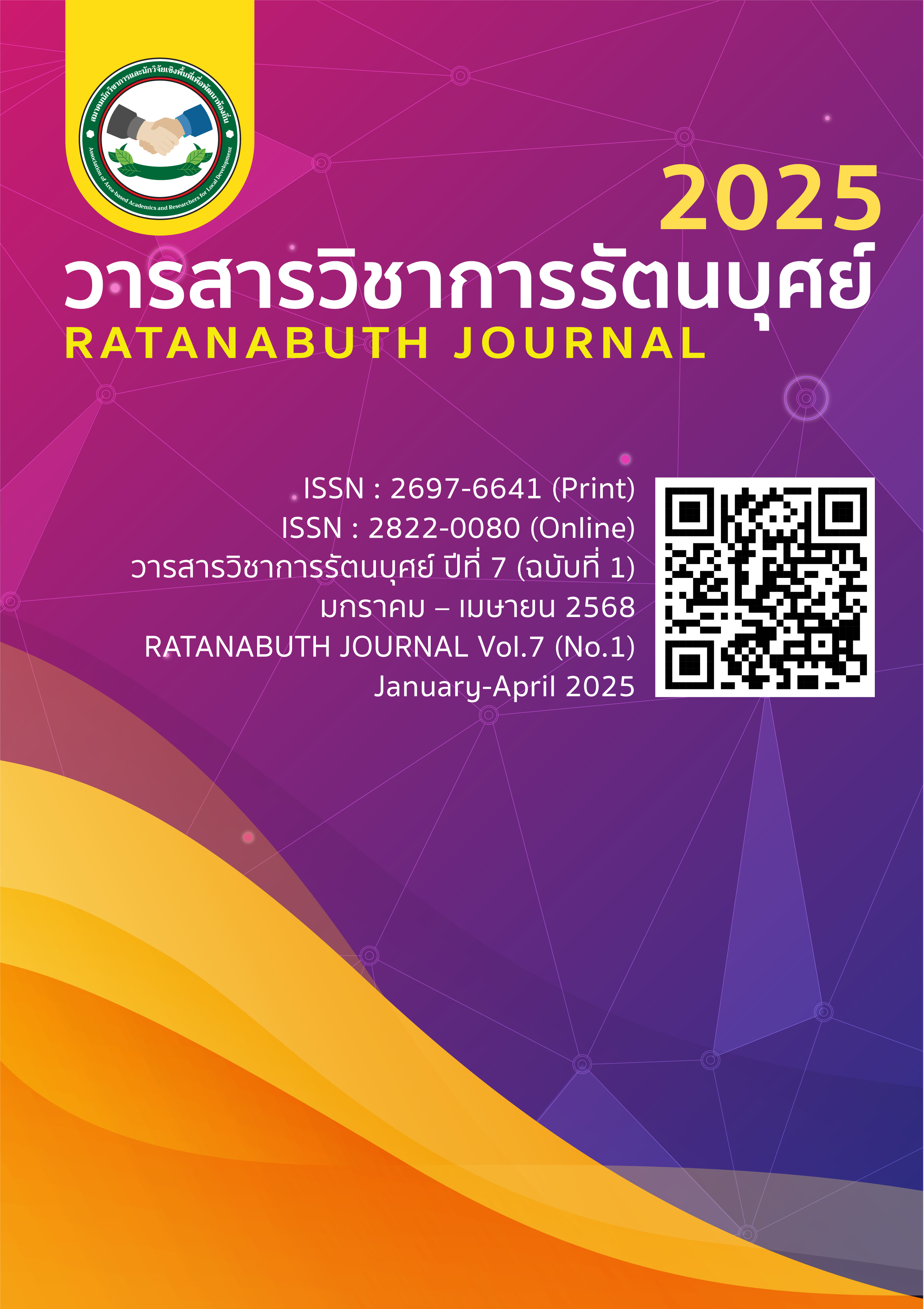The Psychological Behavior Management in School Administration and the Quality of Work Life of Teachers Under the Primary Educational Service Area at a place The Psychological Behavior Management in School Administration and the Quality of Work Life of Teachers Under the Primary Educational Service Area at a place
Main Article Content
Abstract
This research aimed to 1) examine the level of administrative psycho-behavior, 2) study the level of teachers' quality of work life, and 3) identify the relationship between administrative psycho-behavior in educational institutions and teachers' quality of work life within the jurisdiction of a primary educational service area office. The sample group consisted of 184 educational personnel in total. The research instrument utilized was a questionnaire. Statistical methods used for data analysis included percentage calculation, mean, standard deviation, and Pearson's correlation coefficient analysis.
The findings revealed that 1) the overall administrative psycho-behavior in educational institutions was at the highest level. When analyzed by dimension, it was found that the highest-ranked aspect was self-confidence, followed by future orientation and self-control, while the lowest-ranked aspect was ethical reasoning. 2) Teachers' quality of work life was also at the highest level overall. When classified by dimension, it was found that the highest-ranked aspect was job security and career advancement, followed by organizational democracy, while the lowest-ranked aspect was work-life balance. 3) The analysis of the relationship between administrative psycho-behavior in educational institutions and teachers' quality of work life indicated a positive correlation at the overall level and within each dimension, with statistical significance at the 0.01 level.
Article Details

This work is licensed under a Creative Commons Attribution-NonCommercial-NoDerivatives 4.0 International License.
References
กมลพิพัฒน์ ชนะสิทธิ์, เฉลิมชัย กิตติศักดิ์นาวิน,นลินณัฐ ดีสวัสดิ์. (2560). จริยธรรมในการตัดสินใจกับการพัฒนาองค์การ. วารสารมนุษยศาสตร์และสังคมศาสตร์ มหาวิทยาลัยธนบุรี, 11(26), 142–155.
ชูชาติ พลสงคราม. (2560). การบริหารความขัดแย้งในองค์การของบุคลากรสังกัดองค์กรปกครองท้องถิ่นในเขตพื้นที่อำเภอคูเมือง จังหวัดบุรีรัมย์.วิทยานิพนธ์ปริญญามหาบัณฑิต.บุรีรัมย์:มหาวิทยาลัยราชภัฏบุรีรัมย์.
ดวงเดือน พันธุมนาวิน. (2543). ทฤษฎีต้นไม้จริยธรรม: การวิจัยและการพัฒนาบุคคล. โครงการส่งเสริมเอกสารวิชาการ สถาบันบัณฑิตพัฒนบริหารศาสตร์.
ดุจเดือน พันธุมนาวิน. (2550). จิตวิทยาการพัฒนาเด็ก. สำนักพิมพ์ไทยวัฒนาพานิช.
ทยากร สุวรรณปักษ์. (2560). จริยธรรมทางธุรกิจและผลการดำเนินงานของวิสาหกิจขนาดกลางและขนาดย่อมในจังหวัดมุกดาหาร. วารสารมนุษยศาสตร์และสังคมศาสตร์ มหาวิทยาลัยอุบลราชธานี, 4(1), 46–66.
ธนพล สะพังเงิน. (2564). ความสัมพันธ์ระหว่างพฤติกรรมผู้บริหารสถานศึกษากับการปฏิบัติงานของครู สังกัดสำนักงานเขตพื้นที่การศึกษาประถมศึกษาอุดรธานี เขต 3. วารสารการบริหารการศึกษา, 15(2), 23–45.
ในตะวัน กำหอม. (2559). การวิจัยทางการศึกษา. เล่ม 1. วิทยาลัยทองสุข.
บัลลังก์ โรหิตเสถียร. (2558). การพัฒนาคุณภาพชีวิตและการบริหารสถานศึกษา. สำนักพิมพ์มหาวิทยาลัยศรีนครินทรวิโรฒ.
ปิ่นทอง ปราสาทภิญโญ, & วิรัลพัชร วงศ์วัฒน์เกษม. (2567). คุณภาพชีวิตการทำงานของข้าราชการครู สหวิทยาเขตปราสาทเชิงพนม สังกัดสำนักงานเขตพื้นที่การศึกษามัธยมศึกษาสุรินทร์. วารสารการศึกษาและพัฒนา, 18(1), 30–50.
พุทธทาสภิกขุ. (2553). ธรรมะกับการบริหารและการจัดการความขัดแย้ง. โรงพิมพ์มหามกุฏราชวิทยาลัย.
วิกานดา จิรพุทธกร. (2565). ความสัมพันธ์ระหว่างสมรรถนะของผู้บริหารสถานศึกษากับคุณภาพชีวิตการทำงานของครูสังกัดกรุงเทพมหานคร กลุ่มกรุงธนเหนือ. วารสารบริหารและพัฒนาการศึกษา, 14(2), 41–58.
สำนักงานคณะกรรมการการศึกษาขั้นพื้นฐาน. (2542). พระราชบัญญัติการศึกษาแห่งชาติ พ.ศ. 2542. ราชกิจจานุเบกษา.
อันธิกา บุญเลิศ. (2562). ทักษะการบริหารของผู้บริหารกับคุณภาพชีวิตการทำงานของครูในโรงเรียนสังกัดสำนักงานเขตพื้นที่การศึกษามัธยมศึกษา เขต 1. วารสารวิชาการการศึกษา, 10(1), 55–70.
อำนาจ สุนทรธรรม. (2553). คุณภาพชีวิตของครูกับการพัฒนาคุณภาพการศึกษาในยุคโลกาภิวัตน์. สำนักพิมพ์จุฬาลงกรณ์มหาวิทยาลัย.
Erikson, E. H. (1963). Childhood and society. Norton.
Huse, E. F., & Cumming, T. G. (1985). Organization development and change. West Publishing.
Krejcie, R. V., & Morgan, D. W. (1970). Determining sample size for research activities. Educational and Psychological Measurement, 30(3), 607–610.
Walton, R. E. (1973). Quality of working life: What is it?. Sloan Management Review, 15(1), 11–21.

